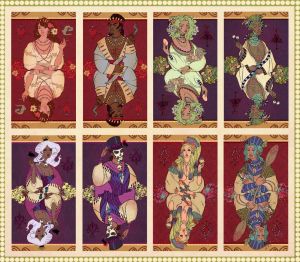(Created page with "thumb|Modern tarot Loa cards In Haitian Voodoo, '''Loa''' are considered intermediaries spirits, which emanate and act on behalf of ''Bondye'' (''Bon Die...") |
|||
| Line 44: | Line 44: | ||
[[Category:Haitian mythology]] | [[Category:Haitian mythology]] | ||
[[Category:Loa]] | |||
Latest revision as of 13:01, 18 May 2012
In Haitian Voodoo, Loa are considered intermediaries spirits, which emanate and act on behalf of Bondye (Bon Dieu, or good god), the Creator, who is distant from the world and humanity.
Description
Loa have been associated with Catholic saints and African deities and their appearance often carry their distinctive features.
The Veve is the religious symbol of the Loa and serves as their representation during rituals. Most similar to the veve are the drawings of zemi or gods of the Taino religion.
Families
There are many families or nanchons (nations) of Loa - Rada (also Radha), Petro (also Pethro, Petwo), Nago, Kongo and Ghede (also Guede, or Gede) to name but a few.
Rada Loa
The Rada Loa are generally the older, more beneficent spirits, and are associated with the gods of Africa. Their traditional colour is white (as opposed to the specific colours of individual Loa). They include Legba, Loko, Ayizan, Anaisa Pye, Dhamballah Wedo and Ayida-Weddo, Erzulie Freda, La Sirène, and Agwe.
Petro Loa
The Petro (or Petwo) Loa are generally the more fiery, occasionally aggressive and warlike Loa, and are associated with Haiti and the New World. Their traditional colour is red. As such, they do not appear in African Vodou practices.
Ghede Loa
The Ghede are the spirits of the dead. They are loud, rude (although rarely to the point of real insult), sexual, and usually a lot of fun. They transport dead souls, behave irreverently, make obscene jokes and perform dances that mimic sexual intercourse. They are led by the Barons La Croix, Samedi, Cimitière, Kriminel and Maman Brigitte. Their traditional colours are black and purple
Kongo Loa
Originating from the Congo region of Africa, these spirits include the many Simbi loa. It also includes the much dreaded Marinette, a fierce and much feared female loa.
Nago Loa
Originating from Nigeria (specifically the Yoruba speaking tribes) this nanchon includes many of the Ogoun spirits.
The lwa also fall into family groups, who share a surname, such as Ogou, Ezili, Azaka or Ghede. For instance, Ezili is a family, Ezili Danto and Ezili Freda are two individual spirits in that family. Each family is associated with a specific aspect, for instance the Ogou family are soldiers, the Ezili govern the feminine spheres of life, the Azaka govern agriculture, the Ghede govern the sphere of death and fertility. Each of the lwa is associated with a particular Roman Catholic saint.
Cult
Unlike saints or angels however, Lwa are not simply prayed to, they are served. Each Loa carries his personal likes and dislikes, distinct sacred rhythms, songs, dances, ritual symbols, and special modes of service.
In Voodoo ceremonies the Loa are called by the Priestess (Mambo) or Priest (Houngan) or sometimes Bokor (Sorcerers). Part of the Voodoo belief is that loa communicate with followers through possession. The possession, called mounting, can be violent or calm, depending on the personality of the Loa.
One allegory often used is that of riding a horse, with the practitioner being the one ridden. The loa temporarily displaces the soul of its host, or medium, and takes control of the medium's body.
Phrases, actions and behavior indicate which Loa is present. When the Loa is identified, the symbols associated with them are offered. For example, Legba will be given his cane, straw hat and pipe; Baron Samedi his top hat, sunglasses and cigar.
According to this belief, the medium cannot feel pain or become injured while possessed. The loa speaks through the medium, often giving instructions, advice or prophecies of future events.

